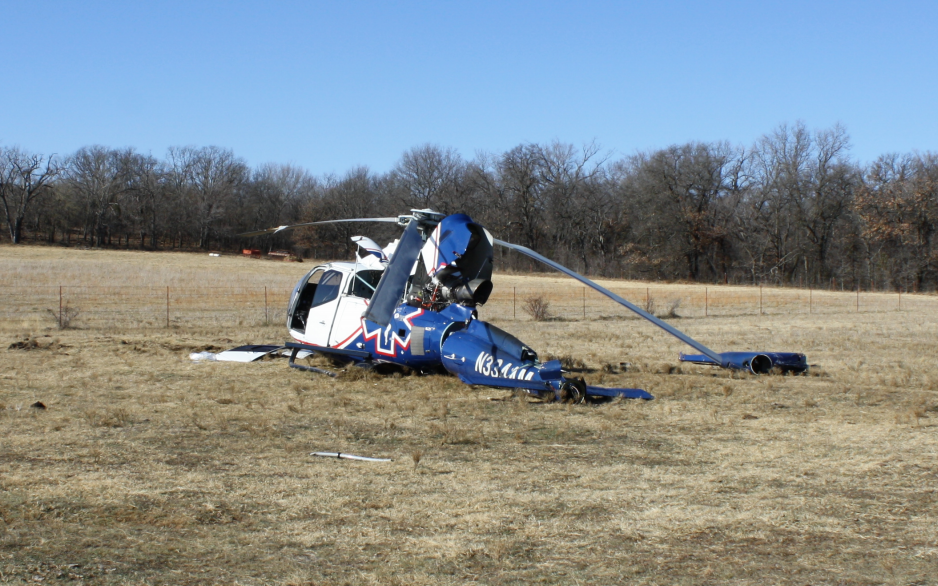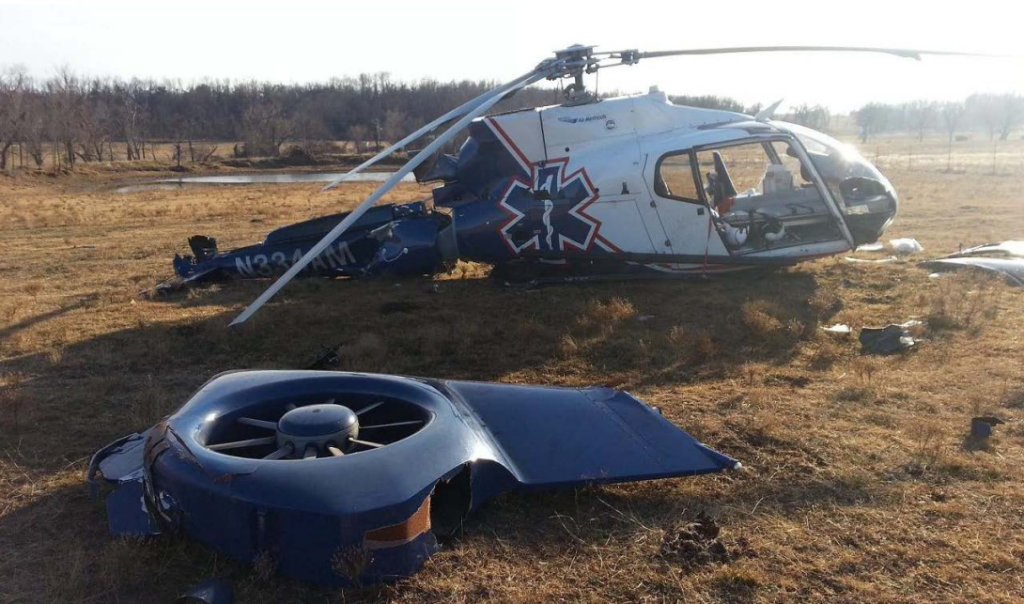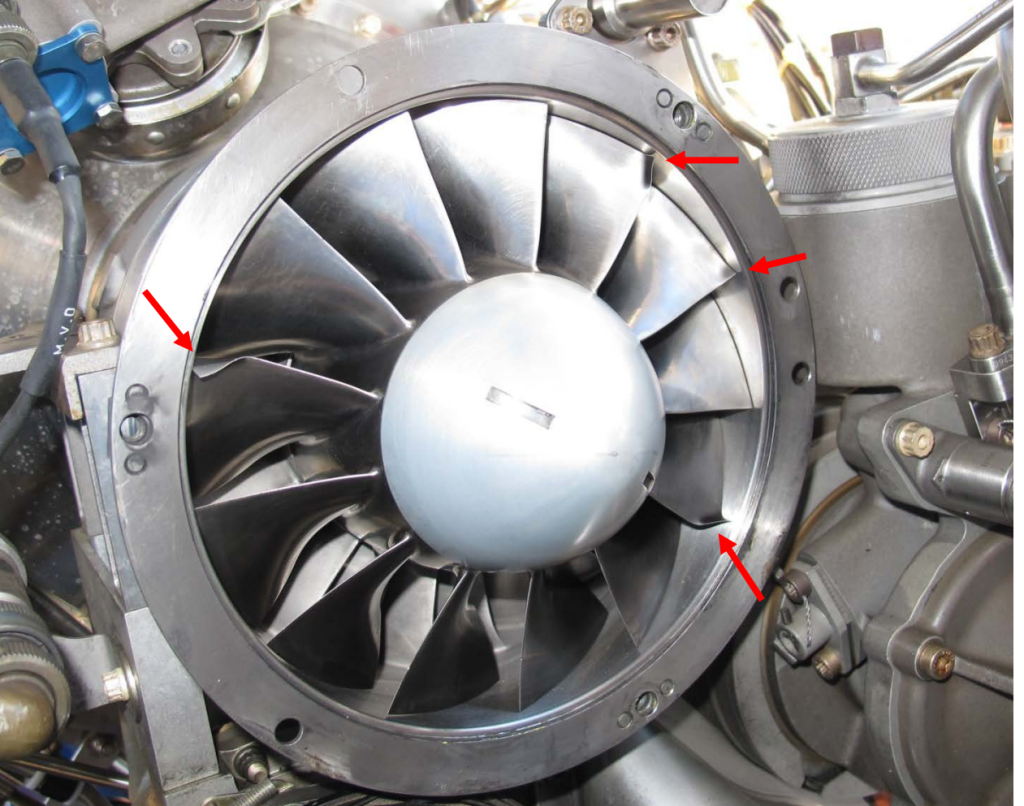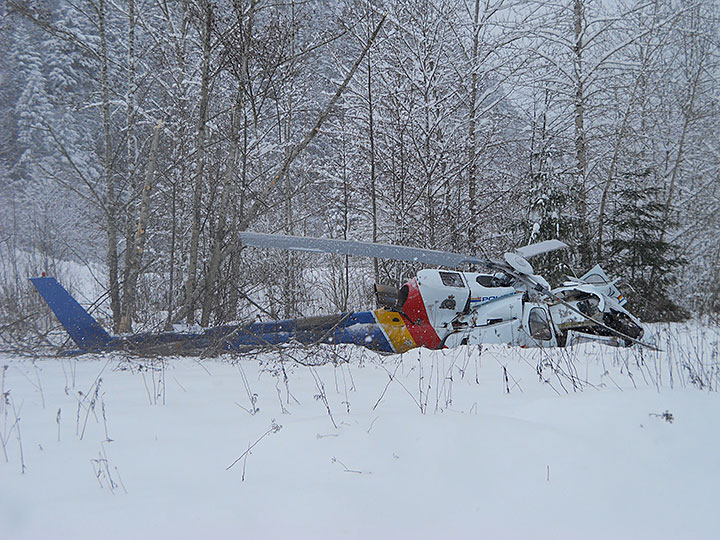Airbus EC130B4 Destroyed After Ice Ingestion – Engine Intake Left Uncovered (Air Methods, N334AM)
On 2 January 2013, Eurocopter EC130B4 HEMS air ambulance helicopter N334AM, operated by Air Methods, experienced a hard landing following a loss of power from its Turbomeca Arriel 2B1 turboshaft engine near Seminole, Oklahoma. The pilot and three medical crew members were all seriously injured.

Wreckage of Air Methods EC130B4 HEMS Helicopter N334AM After Ice Ingestion and Power Loss (Credit: NTSB)
The US National Transportation Safety Board (NTSB) say in their final report, that according to the pilot, the crew…
…received a standby call for a response to an accident scene. The pilot checked weather for the flight. He went and removed the helicopter inlet cover and the flight was requested to launch. The pilot performed a walk around inspection of the helicopter and started the helicopter normally. Shortly after takeoff, while climbing through 1,600 and 1,700 feet mean sea level (msl), the pilot heard a sound like something had struck the helicopter and the engine stopped producing power. The pilot had limited recollection of the next events but recalled that while performing an autorotation, he made a right turn to an open field.
While maneuvering to land to the field he saw a previously undetected barbed wire fence. The pilot maneuvered the helicopter over the fence and [a] crew member reported seeing the sky through the forward windscreen before they impacted the ground.

Wreckage of Air Methods EC130B4 HEMS Helicopter N334AM After Ice Ingestion and Power Loss (Credit: NTSB)
According to the NTSB Airworthiness Group report:
The location of the ground scars relative to the final resting position of the aircraft was consistent with a clockwise rotation of the aircraft of approximately 180 degrees following initial ground impact of the landing skids and the tail skid. A barbed-wire fence was located approximately 16 feet west of the single tail skid ground scar and approximately 54 feet west of the main wreckage.

Wreckage of Air Methods EC130B4 HEMS Helicopter N334AM After Ice Ingestion and Power Loss Showing Ground Scars (Credit: NTSB)
The NTSB explain that:
Engine examination revealed that the four axial compressor blades exhibited significant deformation on the outboard tips of their leading edges in the direction opposite of normal rotation consistent with the ingestion of soft body foreign object debris, such as ice.
Investigation however revealed that:
For 3 days before the accident flight, the helicopter was parked outside without its engine cover installed and was exposed to light drizzle, rain, mist, and fog. The engine inlet cover was installed the day before the accident at an unknown time. The helicopter remained outside and exposed to freezing temperatures throughout the night until 2 hours before the flight.
Although the helicopter was maintained in a ready status on the helipad and maintenance personnel performed daily preflight/airworthiness checks, the inlet to the first-stage of the axial compressor was not inspected to ensure that it was free of ice in accordance with the Aircraft Maintenance Manual.
The NTSBconclude that:
Based on the weather conditions that the helicopter was exposed to during the 3 days before the accident, it is likely that ice formed in the engine air inlet before the flight and that, when the pilot increased the engine power during takeoff, the accumulated ice separated from the inlet and was ingested by the engine and damaged the compressor blades.
NTSB Probable Cause
The loss of engine power due to ice ingestion.
Contributing to the accident was maintenance personnel’s delayed decision to install the helicopter’s engine inlet cover until after the engine had been exposed to moisture and freezing temperatures and their inadequate daily preflight/airworthiness checks, which did not detect the ice formation.
Failure to Learn?
However less than a year earlier, on 17 January 2012, Royal Canadian Mounted Police (RCMP) Eurocopter AS350B3 C-FMPG was destroyed and its pilot killed at Cultus Lake, near Chilliwack, British Columbia. We analysed that accident here: RCMP AS350B3 Left Uncovered During Snowfall Fatally Loses Power on Take Off
According the Transportation Safety Board of Canada (TSB) final report, earlier in the day, the helicopter had deployed from Vancouver to a Canadian Dept of National Defence (DND) site at Cultus Lake. The TSB concluded that:
- The available protective covers for the airframe and the engine air intake were not installed when the helicopter was shut down or when heavy snow began to fall. In addition, preparation of the helicopter for flight, by removal of the accumulated snow from the airframe or the air intake, was not carried out as required by the rotorcraft flight manual.
- Water accumulated in the engine air intake system, and ice or compacted snow built up in the engine air intake plenum after start. The helicopter experienced a complete loss of engine power resulting from a sudden change in air/fuel ratio caused by ingestion of the contaminant.
- The helicopter’s power loss occurred at an altitude and airspeed that did not permit an autorotation, which led to a rapid loss of main-rotor rpm and an extremely high rate of descent.
- As the helicopter descended, the rapid decay in main-rotor rpm resulting from the engine power loss reduced the effectiveness of the flight controls, leading to an impact with terrain that was beyond human tolerances
Safety Action
Eurocopter (now Airbus) issued Safety Information Notice 2645-S-30, in October 2013 applicable to AS350, AS550, and EC130, regarding ice and rain protection.
Other Safety Resources
- Coking Causes Power Loss: Australian AS350BA
- AS350B2 Accident After Vibration from Unrecorded Maintenance
- King Air 100 Stalls on Take Off After Exposed to 14 Minutes of Snowfall: No De-Icing Applied
- Fatal Snowy Powerline Inspection Flight
- Dim, Negative Transfer Double Flameout
- BK117B2 Air Ambulance Flameout: Fuel Transfer Pumps OFF, Caution Lights Invisible in NVG Modified Cockpit
- AAIB Report on Glasgow Police EC135T2+ Clutha Helicopter Accident
- US HEMS EC135 Dual Engine Failure: 7 July 2018
- Accident Report: Fatal Police Helicopter Double Engine Flameout Over City Centre
- Engine Failure after Inadvertently Being Put Back into Service Incomplete
- HF Lessons from an AS365N3+ Gear Up Landing
- Life Flight 6 – US HEMS Post Accident Review
- More US Night HEMS Accidents
- US HEMS “Delays & Oversight Challenges” – IG Report
- Crashworthiness and a Fiery Frisco US HEMS Accident
- HEMS S-76C Night Approach LOC-I Incident
- US HEMS Accident Rates 2006-2015
- HEMS A109S Night Loss of Control Inflight
- US Fatal Night HEMS Accident: Self-Induced Pressure & Inadequate Oversight
- HEMS Black Hole Accident: “Organisational, Regulatory and Oversight Deficiencies”
- When Habits Kill – Canadian MD500 Accident
- UPDATE 7 February 2020: S-61N Damaged During Take Off When Swashplate Seized Due to Corrosion
- UPDATE 25 April 2020: Fatal R44 Loss of Control Accident: Overweight and Out of Balance
- UPDATE 13 September 2020: Hawaiian Air Tour EC130T2 Hard Landing after Power Loss (Part 1)
- UPDATE 9 October: 2020: Latent Engine Defect Downs R44: NR Dropped to Zero During Autorotation
- UPDATE 18 October 2020: Hawaiian Air Tour EC130T2 Hard Landing after Power Loss (Part 2 – Survivability)
- UPDATE 27 December 2020: Fire-Fighting AS350 Hydraulics Accident: Dormant Miswiring
- UPDATE 2 July 2022: Fatal EC130B4 Water Impact in the Tennessee River after “Entry to VRS” Say NTSB



Recent Comments